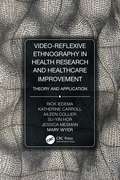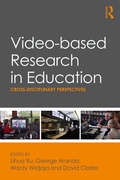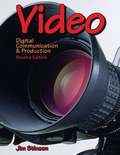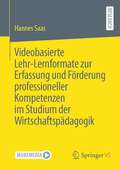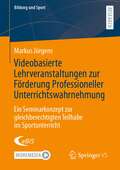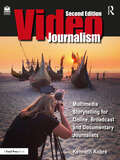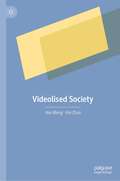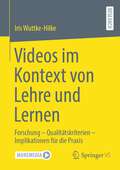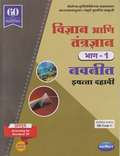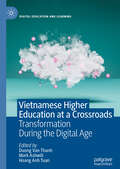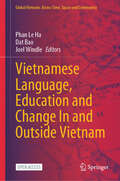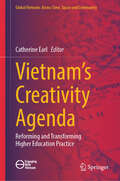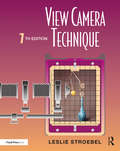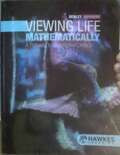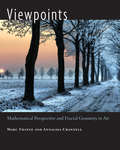- Table View
- List View
Video-Reflexive Ethnography in Health Research and Healthcare Improvement: Theory and Application
by Jessica Mesman Rick Iedema Mary Wyer Katherine Carroll Aileen Collier Su-Yin HorThis innovative, practical guide introduces researchers to the use of the video reflexive ethnography in health and health services research. This methodology has enjoyed increasing popularity among researchers internationally and has been inspired by developments across a range of disciplines: ethnography, visual and applied anthropology, medical sociology, health services research, medical and nursing education, adult education, community development, and qualitative research ethics.
Video-based Research in Education: Cross-disciplinary Perspectives
by David Clarke Lihua Xu George Aranda Wanty WidjajaThe rapid development of video technology in the last decade has changed the ways in which people communicate, how they learn, and how research is done. Video technology offers rich potential in capturing complex social interactions over a prolonged period of time and in supporting teacher professional learning and development. This book explores the ontological, epistemological, methodological, and ethical challenges associated with the different uses of video in research, ranging from video as a tool for investigating social interactions and for stimulating participants’ reflection, to the use of video for engaging varied communities and social groups in the process of teaching, learning and research. Each chapter presents the authors’ critical reflection on the ways in which video was employed, the research decisions made, the methodological challenges faced, and the consequences for how educational practices were understood. As such, it illustrates a wide range of philosophical and theoretical standpoints with respect to video-based research approaches. This book will stimulate broad and rich discussion among education researchers who are interested in video research and contributes to: advancing knowledge of the field; developing approaches to dealing with emergent ethical, theoretical, and methodological issues; and generating new protocols and guidelines for conducting video-based research across a variety of disciplinary areas in education.
Video: Digital Communication & Production
by Jim StinsonComprehensive textbook designed as a complete introductory course in video-the 21st centruy hybrid of television and film techniques that is the future of all media production.
Videobasierte Kompetenzmessung in der universitären Lehrkräfteausbildung: Evidenz aus Literaturreviews und empirischen Untersuchungen (Perspektiven der Mathematikdidaktik)
by Jonas WeyersInnerhalb der Forschung zur professionellen Kompetenz von Lehrkräften kommen vermehrt videobasierte Kompetenzmessungen zum Einsatz. Durch die Kombination von Videomaterial unterrichtlicher Praxis mit spezifischen Testfragen sollen Rückschlüsse auf handlungsnahe Kompetenzen bzw. sogenannte situationsspezifische Fähigkeiten von Lehrkräften ermöglicht werden. Auf Basis von zwei Literaturreviews untersucht die vorliegende Arbeit die Konzeption und Erfassung situationsspezifischer Fähigkeiten am Beispiel des Konstrukts "Teacher Noticing", welches in der mathematikdidaktischen Forschung besonders verbreitet ist, und gibt einen umfassenden Überblick zu vorliegenden Testinstrumenten, die auf dieses Konstrukt abzielen. Insbesondere wird diskutiert, inwieweit unterschiedliche Messansätze zu vergleichbaren Ergebnissen führen und welche Konsequenzen sich aus der Heterogenität der Messansätze für den wissenschaftlichen Diskurs ergeben. Anhand zweier empirischer Arbeiten wird weiterführend geprüft, inwieweit anspruchsvolle videobasierte Kompetenzmessungen bereits mit Lehramtsstudierenden einsetzbar sind und Rückschlüsse auf deren Kompetenzentwicklung zulassen. Die Ergebnisse stützen dabei grundsätzlich die Einsetzbarkeit in der universitären Phase der Lehrkräfteausbildung, wobei sich nur geringe Zusammenhänge zu den Lerngelegenheiten innerhalb dieses Ausbildungsabschnitts zeigen.
Videobasierte Lehr-Lernformate zur Erfassung und Förderung professioneller Kompetenzen im Studium der Wirtschaftspädagogik
by Hannes SaasProfessionelle Kompetenzen haben entscheidenden Einfluss auf die individuelle Bewältigung beruflicher Anforderungssituationen und sind zentrale Voraussetzung für ein erfolgreiches berufliches Handeln. Die professionelle Kompetenz umfasst die Fähigkeit, flexibel auf das eigene Professionswissen zurückzugreifen und es zur Lösung komplexer, praxisnaher Probleme anzuwenden. Die Arbeit präsentiert einen hochschuldidaktischen Ansatz, der Studierende auf die Bewältigung dieser beruflichen Anforderungssituationen in wirtschaftspädagogischen Tätigkeitsfeldern vorbereitet. Zunächst werden die professionellen Kompetenzen von Wirtschaftspädagoginnen und -pädagogen ausdifferenziert. Zudem wird die ELMaWi-Validierungsstudie vorgestellt, aus der ein videobasiertes Testinstrument zur Erfassung aktionsbezogener und reflexiver Kompetenzen von Lehrkräften mit Fach Wirtschaft hervorging. Der Transfer dieses ELMaWi-Instruments in die universitäre Ausbildungspraxis ermöglicht eine valide Erfassung und Überprüfung der professionellen Kompetenzen von Studierenden der Wirtschaftspädagogik. Schließlich widmet sich der Autor der Konzeption und Überprüfung eines videobasierten Lehr-Lernformats zur fachspezifischen Förderung jener professioneller Kompetenzen, die zur Bewältigung komplexer Anforderungssituationen im schulischen und betrieblichen Handlungskontext erforderlich sind.
Videobasierte Lehrveranstaltungen zur Förderung Professioneller Unterrichtswahrnehmung: Ein Seminarkonzept zur gleichberechtigten Teilhabe im Sportunterricht (Bildung und Sport #30)
by Markus JürgensIn diesem Buch entwickelt Markus Jürgens ein videobasiertes Seminar zur Förderung der Professionellen Unterrichtswahrnehmung im inklusiven Sportunterricht. Das in der Arbeit ausdifferenzierte Wahrnehmungskonzept der gleichberechtigen Teilhabe an Spielen im Sportunterricht kann in der Sportlehrerbildung gezielt zur Wahrnehmung von Unterrichtssituationen eingesetzt werden. Für die Evaluation des Seminars konzipiert der Autor ein sportspezifisches Instrument zur Erhebung der Professionellen Unterrichtswahrnehmung, das auf einer videobasierten Fallanalyse mit offenem Antwortformat aufbaut. Das Instrument wird in einer seminarbegleitenden Studie in Rahmen eines Prä-Post-Kontrollgruppendesigns eingesetzt.
Videojournalism: Multimedia Storytelling for Online, Broadcast and Documentary Journalists
by Kenneth KobreVideojournalism: Multimedia Storytelling for Online, Broadcast and Documentary Journalists is an essential guide for solo video storytellers—from "backpack" videojournalists to short-form documentary makers to do-it-all broadcast reporters.Based on interviews with award-winning professionals sharing their unique experiences and knowledge, Videojournalism covers topics such as crafting and editing eye-catching short stories, recording high-quality sound, and understanding the laws and ethics of filming in public and private places. Other topics include:• understanding the difference between a story and a report• finding a theme and telling a story in a compact time frame• learning to use different cameras and lenses—from smart phones to mirrorless and digital cinema cameras• using light, both natural and artificial • understanding color and exposureThe second edition of this best-selling text has been completely revised and updated. Heavily illustrated with more than 550 photographs, the book also includes more than 200 links to outstanding examples of short-form video stories. Anatomy of a News Story, a short documentary made for the book, follows a day in the life of a solo TV videojournalist on an assignment (with a surprise ending), and helps readers translate theory to practice.This book is for anyone learning how to master the art and craft of telling real, short-form stories with words, sound, and pictures for the Web or television.A supporting companion website links to documentaries and videos, and includes additional recommendations from the field’s most prominent educators.
Videolised Society
by Hui Zhao Jian MengThis book traces the development of video (especially short video, duan shipin) in China over the past few years, exploring how these videos engaged with China’s rapidly changing society, how they enriched existed theories of society, media and communication, and new theories to be extracted. The book offers a new, critical model for understanding the relationship between video, video theory, video industry and the State. This book sheds light on the overall description and explanation of the current socio-political, economic and cultural environment concerning the development of video (especially short video). It interprets the emergence of the “Social Videolization” through the subjects of media psychology, communication studies and cultural criticism, media industrial studies, sociology and anthropology.
Videos im Kontext von Lehre und Lernen: Forschung – Qualitätskriterien – Implikationen für die Praxis
by Iris Wuttke-HilkeIn diesem Buch wird der Stand der Forschung zu Videos in institutionellen Lehr-Lern-Kontexten erfasst und Klarheit in Begrifflichkeiten und Charakteristika von Lehrvideos, Erklärvideos und Tutorials gebracht. Das Buch liefert einen detaillierten Kriterienkatalog, der zugleich die Grundlage bildet für die umfassende Analyse von 70 frei zugänglichen Videos zu technischen Sachverhalten im Alltagskontext. In einem Modell werden kognitive und affektive Elemente und Bezüge bei Videos in Lehr-Lern-Kontexten dargestellt, die jedem bewusst sein sollten, der mit Videos lehrt oder lernt. Ein Kapitel zum Transfer der Erkenntnisse in die Praxis gibt Anregungen hinsichtlich der niederschwelligen Videoerstellung, z.B. im Bereich technischer Bildung oder für Wissensweitergabe in Unternehmen. So liefert dieses Buch mit dem Brückenschlag von formellen hin zu alltäglichen, individuellen Lehr-Lern-Kontexten ein verdichtetes Gesamtbild zu Videos und ermöglicht interessierten Leserinnen und Lesern die fundierte Auseinandersetzung mit Videos als digitales Lehr-Lern-Format.
Vidhyarthigaagi
by Swami PurushotamaanandaThis book mainly focussed on the student's. The first article describes about concentration formulas as 'concentration in the study', but in the past they must have a knowledge of the way in which life can be streamlined. It has taught in the second article 'Letter to a Student'.
Vidnyan Ani Tantradnyan Bhag 1 Digest Class 10th Maharashtra Board - Guide: विज्ञान आणि तंत्रज्ञान भाग 1 डाइजेस्ट इयत्ता 10वी महाराष्ट्र बोर्ड - मार्गदर्शन
by Shri Navneetविज्ञान आणि तंत्रज्ञान भाग 1 इयत्ता 10वी चे पुस्तक नवनीत एज्युकेशन लिमिटेडने मराठी भाषेमध्ये प्रकाशित केलेले आहे, या पाठपुस्तकामधे दहा पाठ व त्यांची प्रश्नोत्तरे आणि बोर्डाची कृतिपत्रिका दिलेली आहे. प्रत्येक प्रकरणाच्या सुरुवातीला दिलेल्या 'महत्त्वाचे मुद्दे' यात, प्रकरणामध्ये असलेल्या सर्व अभ्यासघटकांचा समावेश आहे. काही ठिकाणी मुद्द्यांच्या स्वरूपात, तर काही ठिकाणी तक्त्यांच्या स्वरूपात माहितीची मांडणी करण्यात आली आहे. पाठ्यपुस्तकात आलेले 'सांगा पाहू' किंवा 'थोडे आठवा' या बाबी ‘महत्त्वाचे मुद्दे' यांत समाविष्ट करण्यात आल्या आहेत. यातील प्रश्नांची उत्तरे मिळाल्यावर किंवा कृती केल्यावर, त्यानंतर दिलेल्या मुद्द्यांचे आकलन होणे खूपच सोपे होईल, हा त्याचा मुख्य उद्देश आहे.
Vidyarthigaligagi Kathegalu Bhaga- 1
by Swami RaghaveshaanandaTwenty one short stories for the Students.
Vidyarthigaligagi Kathegalu Bhaga- 2
by Swami RaghaveshaanandaTwenty four short stories for the Students.
Vidyasagar: The Life and After-life of an Eminent Indian (Pathfinders)
by Brian A. HatcherThis book offers a new interpretation of the life and legacy of the Indian reformer and intellectual, Ishvarchandra Vidyasagar (1820–91). Drawing upon autobiography, biography, secondary criticism and a range of Vidyasagar’s original writings in Bengali, the book interrogates the role of history, memory and controversy, and emphasises the key challenge of pinning down the identity of an enigmatic and multi-faceted figure. By examining lesser-known works of Vidyasagar (including several pseudonymous and posthumous works) alongside the evidence of his public career, the author calls attention to the colonial transformation of intellectual and social life, the nature of life writing, the limits of standard biographies and the problem of modern Indian identity as such. Based on decades of research and an original perspective, this book will be especially useful to scholars of modern Indian history, biographical studies, comparative literature and those interested in Bengal.
Vielfalt von hochschulischen Bildungsverläufen: Wege in das, durch das und nach dem Studium (Higher Education Research and Science Studies)
by Sandra Buchholz Jessica Ordemann Frauke PeterIndividuelle Bildungs- und Lebenswege sind heute weit vielfältiger als oftmals angenommen. Viele Wege mit und ohne Hochschulzugangsberechtigung führen zu unterschiedlichen Zeitpunkten in die hochschulische Bildung. Vielfalt bleibt auch im Studium und danach bestehen. Studierende haben unterschiedliche Hintergründe, sie orientieren sich bei der Studienfachwahl um, unterbrechen das Studium oder brechen es ab. Dieser Vielfalt gehen die aktuellen Befunde in diesem Sammelband eindrucksvoll nach – von den Wegen in ein Studium bis in den Arbeitsmarkt hinein.
Vietnam Over the Long Twentieth Century: Becoming Modern, Going Global (Global Vietnam: Across Time, Space and Community)
by Liam C. Kelley Gerard SasgesThis open access book provides fascinating insights into the incredible changes that Vietnam underwent in the long twentieth century as it transformed from an early modern kingdom to a European colony, to a divided land with opposing ideologies, and to a unified country in a globalized world. At each stage in this long century of changes, there were Vietnamese who sought to mold their society into some vision of “modernity.” The book looks at multiple, rather than one form of modernity, and links those forms with the different political moments that Vietnam experienced, in tandem with the outside interlocutors that were maintained during those periods. As such, this book provides a holistic view of the many forms of modernity and their global links that can be found in Vietnam over the course of the long twentieth century. These multiple modernities are documented in this book, and the authors do so by bringing together the strengths of “traditional” language-based area studies scholarship with the insights that an awareness of trans-national and global perspectives provides. Relevant to historians and researchers in the broader arena of Southeast Asian studies with a particular interest in Vietnam—its journey from past to present—this book is a must-read engagement with a country that has undergone and continues to experience, rapid transformation.
Vietnamese Higher Education at a Crossroads: Transformation During the Digital Age (Digital Education and Learning)
by Hoang Anh Tuan Duong Van Thanh Mark AshwillThis edited volume explores key challenges facing Vietnamese universities amidst digital transformation, navigating the intersection of technology and cultural values, competition, and open education. Chapters in this book offer insights into the current landscape of Vietnamese higher education, outlining strategies for institutional success and preparing students for post-graduation careers. Covering topics such as new teaching and research trends, online learning, course development practices, and support mechanisms for student success, this book provides essential guidance for both public and private universities. It emphasizes strategies to enhance student outcomes within degree programs and optimize the effectiveness of online courses.
Vietnamese Language, Education and Change In and Outside Vietnam (Global Vietnam: Across Time, Space and Community)
by Dat Bao Phan Le Ha Joel WindleThis open access edited book attempts to break new ground in investigating multiple facets of Vietnamese language, education and change in global contexts, engaging with global Vietnam through complex lenses of language and education. Issues of language, globalization, and global identities have often been framed through the lens of hierarchical/binary power relations, and/or through a dichotomy between hyper-central languages, such as English, and revisualized or marginalized local language and cultures. In this book, this dichotomy is turned on its head by considering how Vietnam and Vietnamese are constructed in and outside Vietnam and enacted in global spaces of classrooms, textbooks, student mobility, community engagement, curriculum, and intercultural contacts. Vietnamese is among the world’s most spoken languages and is ranked in the top 20th in terms the number of speakers. Yet, at the same time, as a ‘peripheral’ or ‘southern’ global language as often seen in the Global North-Global South spectrum, the dynamics of multilingual and multicultural encounters involving Vietnamese generate distinctive dilemmas and tensions, as well as pointing to alternative ways of thinking about global phenomena from a fresh angle. Rather than being outside of the global, Vietnamese - like many other ‘non-central’ global languages - is present in diasporas, commercial, and transnational structures of higher education, schooling, and in the more conventional settings of primary and secondary school, in which visions of culture and language also evoke notions of heritage and tradition as well as bring to the fore deep seated ideological conflicts across time, space, communities, and generations. Relevant to students and scholars researching language, education, identity, multiculturalism, and their intersections, particularly related to Vietnam, but also in Southeast Asia and beyond, this volume is a pioneering investigation into overlooked contexts and languages from a global, southern-oriented perspective."This book presents an eclectic collection of 15 chapters unified by an interest in developing and teaching the Vietnamese language. To my knowledge, there has been no previous attempt to make the national language of Vietnam a focus for as many perspectives as are documented in the book. In this regard, the book makes an original and intriguing contribution to the literature on Vietnamese culture, including the culture of Vietnam’s expanding diaspora. The book is pioneering in the extent to which it draws attention to the many roles played by a national language in a nation’s political, social and cultural development. It also documents the challenges of preserving a national language in settings where it is at risk of being marginalized. It is pleasing that so many of the contributing authors are young Vietnamese scholars who can provide a distinctly Vietnamese perspective on concepts and practices of global significance."- Dr. MartinHayden, Emeritus Professor of Higher Education, Southern Cross University, Australia "Vietnamese Language, Education and Change In and Outside Vietnam brings together an excellent collection of chapters that highlight the diverse and important but under-explored roles Vietnamese language plays in different settings within and outside Vietnam. The fifteen chapters of this much needed book provide unique insights into various aspects and meanings of Vietnamese language. Collectively, the volume contributes to broadening our view about the evolution and transformation of Vietnamese language under the impacts of local, national, regional and global forces. The book invites readers to engage in a reflective and intersectional approach to rethinking and re-examining our understandings of the changes and developments of Vietnamese language over the history of the country."- Dr Ly Tran, Professor, Centre for Research for Educational Impact (REDI), Deakin University, Australia, and Founder: Australia-Vietnam
Vietnam’s Creativity Agenda: Reforming and Transforming Higher Education Practice (Global Vietnam: Across Time, Space and Community)
by Catherine EarlThis book gathers a diverse set of empirical research chapters from practitioners in the higher education sector in Vietnam to explore the effects of higher education reform on university learning and teaching from the point of view of the classroom educators. Through action research, reflective practice, and other qualitative methods, the book investigates the transformations of learning and teaching practice from top-down to bottom-up, teacher-centred to student-centred, curriculum-oriented to skills-based, institutionally directed to partner integrated, and co-designed approaches. In doing so, the book challenges a rethinking of Vietnamese higher education. It reveals the ingredients for transformative education and calls for educators to be empowered with support, resources, and trust. Drawing on a broad range of disciplinary backgrounds about Vietnam’s university reforms, it is highly relevant to social anthropologists, educational specialists, and policymakers working in higher education reform, not only in Vietnam and other Southeast Asian contexts, but globally.
Vietnam’s Social Mobility of Science and Technology Human Resource: Opportunities and Challenges in the Context of the Fourth Industrial Revolution
by Dao Thanh Truong Dang Kim Khanh Ly Nguyen Thi Quynh AnhThe book adopts a cognitive perspective on social mobility and its management, addressing gaps and paradoxes in developing science and technology (S&T) human resources at both organizational (particularly universities) and national levels in Vietnam, through sociological and policy approaches. It explores key themes such as social mobility theory, talent attraction challenges in the fourth industrial revolution, the revolution&’s impact on mobility, various types of mobility, influencing factors, and strategies for managing mobility. By understanding these "general laws of social mobility," researchers and policymakers can refine theories on brain circulation, talent attraction, and mobility flow management. Each chapter fosters multi-dimensional dialogue and stakeholder engagement in managing Vietnam's S&T human resources within social mobility and industrial revolutions. The book emphasizes "community knowledge" and "knowledge at large", shifting the focus beyond the individual and calling for deeper dialogue within the framework of positive psychology.
View Camera Technique
by Leslie StroebelNow in its seventh edition, View Camera Technique is a unique, comprehensive book that presents clearly and precisely the features, operations and applications of view cameras. It details camera movements, image formation, exposure control, and information concerning lenses and accessories. Diagrams, comparison charts, and more than 500 photographs and illustrations by distinguished professional photographers provide the reader with the tools necessary to analyze a picture situation, set up and manipulate the camera, and portray the subject to meet the expectations of the professional photographer. This text has been completely revised and updated to include over 100 brand-name view cameras, and offers comparison tables to assist readers in choosing cameras, lenses, and view-camera digital backs. This latest edition offers expanded coverage of the newest technology, including electronic features that simplify the use of view cameras for conventional photography and digital view cameras that eliminate the need for film and make it possible to modify the digital images with image-processing computer software programs
Viewing Life Mathematically: A Pathway to Quantitative
by Kim DenleyThis second edition features fourteen chapters that teach key mathematical concepts while encouraging curiosity about how things relate in the world. Topics like sports and art are now interwoven throughout the book, and a new chapter on data science introduces students to analyzing and storytelling with data. Expanded sections on algebraic methods, updated examples, real-world data, and Excel-based tools help develop practical skills. With a conversational approach, the text is designed to be both readable and engaging for all students.
Viewpoints: Mathematical Perspective and Fractal Geometry in Art
by Annalisa Crannell Marc FrantzAn undergraduate textbook devoted exclusively to relationships between mathematics and art, Viewpoints is ideally suited for math-for-liberal-arts courses and mathematics courses for fine arts majors. The textbook contains a wide variety of classroom-tested activities and problems, a series of essays by contemporary artists written especially for the book, and a plethora of pedagogical and learning opportunities for instructors and students. Viewpoints focuses on two mathematical areas: perspective related to drawing man-made forms and fractal geometry related to drawing natural forms. Investigating facets of the three-dimensional world in order to understand mathematical concepts behind the art, the textbook explores art topics including comic, anamorphic, and classical art, as well as photography, while presenting such mathematical ideas as proportion, ratio, self-similarity, exponents, and logarithms. Straightforward problems and rewarding solutions empower students to make accurate, sophisticated drawings. Personal essays and short biographies by contemporary artists are interspersed between chapters and are accompanied by images of their work. These fine artists--who include mathematicians and scientists--examine how mathematics influences their art. Accessible to students of all levels, Viewpoints encourages experimentation and collaboration, and captures the essence of artistic and mathematical creation and discovery. Classroom-tested activities and problem solving Accessible problems that move beyond regular art school curriculum Multiple solutions of varying difficulty and applicability Appropriate for students of all mathematics and art levels Original and exclusive essays by contemporary artists Forthcoming: Instructor's manual (available only to teachers)
Viewpoints: Readings Worth Thinking and Writing About (5th edition)
by W. Royce AdamsViewpoints, a thematically organized reader, offers diverse perspectives on various themes and issues, such as work, media, human behavior, and cultural heritage. With opening chapters of substantial writing and reading instruction and with writing assignments both at the end of each reading and on the Web, Viewpoints, is an ideal reader for honing writing and critical-thinking skills. Students love Viewpoints, for its helpful guidance, such as pre-reading techniques; methods on evaluating an essay for content, structure, and point-of-view; and advice on choosing good essay topics. The Sixth Edition now includes new opportunities for collaboration.
Views Beyond the Border Country: Raymond Williams and Cultural Politics (Critical Social Thought)
by Dennis L. Dworkin Leslie G. RomanFirst Published in 1993. Routledge is an imprint of Taylor & Francis, an informa company.
